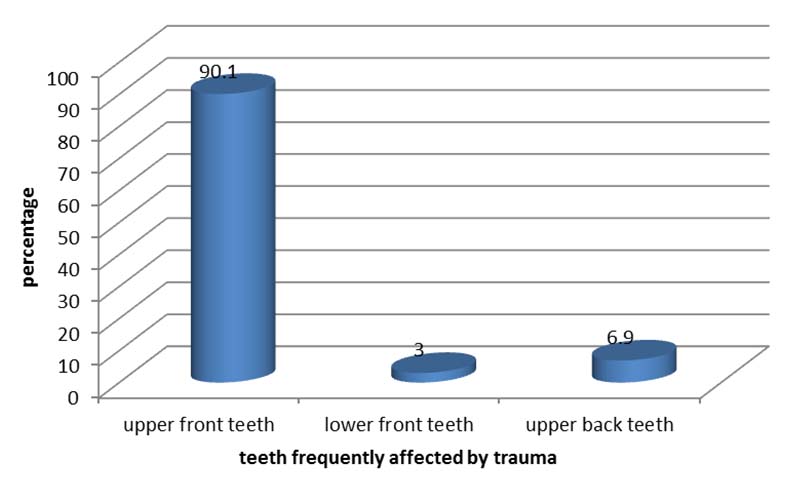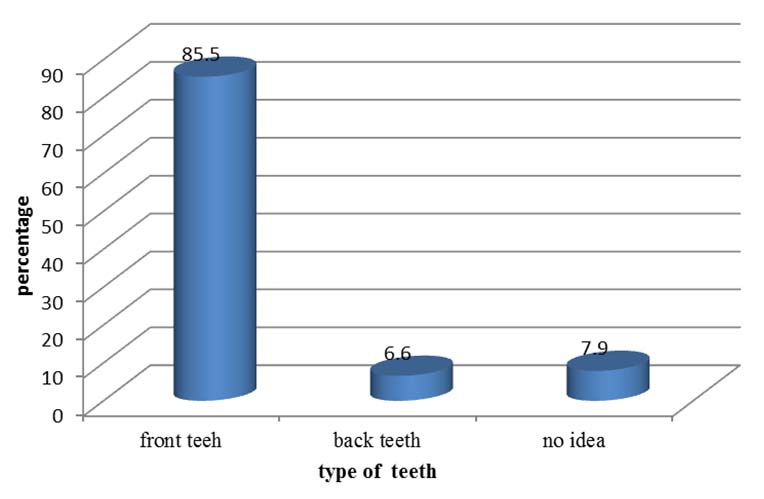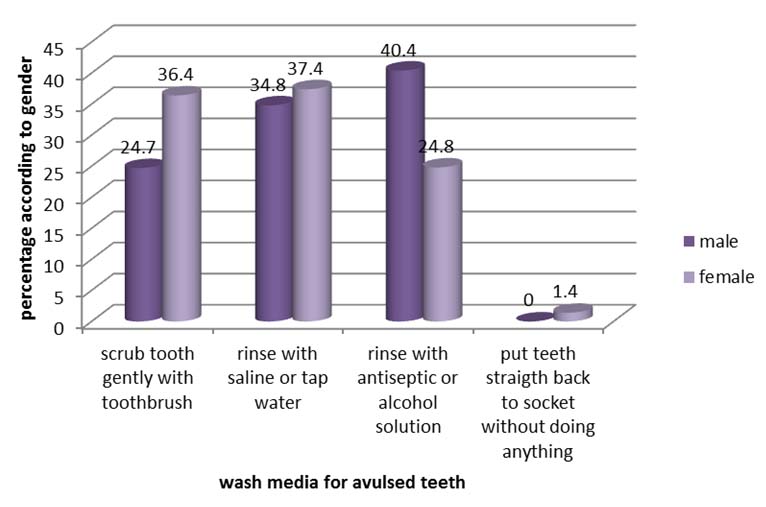Traumatic injuries to both the permanent and primary dentition and their supporting structures have been one of the most important oral health problems in children. Among the young people it has been found that dental trauma can overtake dental caries and periodontal disease as the most significant threat to dental health. Traumatic dental injuries can pose significant consequences to the health-related aspects and subsequently on children’s daily life. This is because these patients are not only functionally affected, but are also psychologically and socially affected [1].
Knowledge of lay people such as child’s parents and school teachers is very important since the prognosis of traumatized teeth depends on prompt and appropriate treatment [5]. Immediate care is particularly important for the avulsed permanent tooth as the prognosis stays high as long as the replantation takes place within 30 minutes after avulsion. The prognosis of the avulsed tooth depends on the viability of periodontal ligament remaining on the root surface [6].
The role of school teachers in the prevention of traumatic dental injuries is a topic that has received a great deal of attention in recent years [7]. Most of the studies conducted in different regions of the world have demonstrated that teachers and other lay people’s knowledge about traumatic dental injuries is inadequate, so their attitude does not brought any reduction in dental trauma and its sequelae [8].
In order to contribute to establish effective strategies of education regarding traumatic dental injuries, this study was conducted. The aim of this study was to evaluate the knowledge of school teachers about dental trauma and its management in Kannur district.
Materials and Methods
The cross sectional study was conducted in Kannur District of Kerala, India by the Department of Paedodontics and Preventive Dentistry, Kannur Dental College and included 300 school teachers from 16 schools, four schools each from four taluks of Kannur district. The schools were selected in order to represent the whole district by stratified cluster sampling technique. School teachers selected were teaching students/children aged 6-15 years. Sample size was calculated based on the key article using the formula
n=4pq/d2
p=prevalence
q=100-p
d-allowable error
based on the key article
prevalence=38%
q=62%
d=15% of p
n=4pq/d2=289 (rounded off to 300)
The study was conducted over a period of one month from 15th June 2014 to 15th July 2014. The nature and purpose of the study was first explained to the teachers in local language. The voluntary nature of the study was emphasized and strict confidentiality was assured. Following this, the printed questionnaire was distributed to school teachers. The questionnaire was prepared based on the needs of the study after referring similar questionnaires used in studies conducted in different parts of the world [1,3,6]. The questionnaire consisted of three major parts. Part 1 comprised of information on the personal and professional profile of the respondents, typically covering age, gender, and length of service, section in school and ultimately their level of education. Part II of the questionnaire comprised questions assessing participants’ knowledge with regard to dentition and dental trauma. Part III of the questionnaire was aimed at evaluating the attitudes of the teachers towards dental trauma and their experience.
The data obtained from the study was used to investigate the effect of age, gender, and length of service, educational background and participants’ teaching section on their knowledge and attitudes towards dental trauma. Statistical analysis was performed using Windows SPSS (SPSS 17 Inc., Chicago, IL, USA).
Results
Out of the 303 teachers (although sample size calculated was 300, while conducting the study, an excess of three teachers was obtained) who participated in the study, 19.8% were in the age group of 20-30 years, 40.9% were in the age group of 30-40 years, 27.7% were in the age group of 40-50 years and 11.6 %were in the age group of 50 years and above [Table/Fig-1].
Demographic characteristics of the teachers expressed in percentage.
| Age Group | % |
|---|
| 20-30 | 19.8 |
| 30-40 | 40.9 |
| 40-50 | 27.7 |
| 50 and above | 11.6 |
| Gender |
| male | 29.4 |
| female | 70.6 |
| Education |
| diploma | 6.3 |
| degree | 57.1 |
| postgraduate | 30.7 |
| any other | 5.9 |
| Years of Experience |
| 0-10 | 34.3 |
| 10-20 | 40.3 |
| 20-30 | 18.5 |
| >30 | 6.9 |
| Section in School |
| lower primary | 14.5 |
| upper primary | 41.6 |
| high school | 43.9 |
Most of the teachers were in the age group of 30-40 years. Majority of the participants were females. A 57.1% of them graduates.
Out of the total school teachers who participated in the study 90.1% responded correctly that the teeth most frequently affected by traumatic accidents are the upper front teeth. A total of 3% answered that lower front teeth are most frequently traumatized and 6.9% went with the option of upper back teeth [Table/Fig-2]. A total of 48.2% had witnessed dental emergency in the school premises [Table/Fig-3]. Nearly, 23.4% responded correctly regarding management of traumatic tooth fracture [Table/Fig-4]. Majority of teachers (85.5%) had correct knowledge regarding the teeth most frequently avulsed [Table/Fig-5]. A total of 46.5% had correct knowledge regarding the reimplantation of avulsed permanent teeth [Table/Fig-6]. A 45.9% responded correctly to the urgency in replanting avulsed teeth [Table/Fig-7]. Nearly, 29.4% had correct knowledge regarding the washing medium for avulsed teeth [Table/Fig-8,9]. Only 14.2% responded correctly to the proper storage medium for avulsed teeth [Table/Fig-10].
Knowledge of teachers regarding which teeth are most frequently affected by traumatic accidents.

Teachers who came across dental emergency in the school premises.
| Number | Percent |
|---|
| Number of teachers who witnessed | 146 | 48.2 |
| Not witnessed | 157 | 51.8 |
| Total | 303 | 100.0 |
Knowledge of teachers regarding management of traumatic tooth fracture.
| Number | Percent |
|---|
| Contact parents and advise them to take the child to a clinic | 224 | 73.9 |
| Reassure the child and send his/her to class | 2 | 0.7 |
| Search for pieces of fractured teeth and take the child to dentist immediately | 71 | 23.4 |
| After class contact parents to explain what had happened | 6 | 2.0 |
| Total | 303 | 100.0 |
Teacher’s knowledge regarding most frequently avulsed teeth.

Knowledge of teachers regarding the replantation of avulsed permanent teeth.
| Number | Percent |
|---|
| The tooth should be replaced immediately | 69 | 22.8 |
| There would be no use in replacing the tooth back to socket | 44 | 14.5 |
| It should be taken to the dentist to reimplant | 141 | 46.5 |
| No idea | 49 | 16.2 |
| Total | 303 | 100.0 |
Knowledge of teachers regarding the urgency in replanting an avulsed tooth.
| Number | Percent |
|---|
| It should be carried out within 30 min of the accident | 139 | 45.9 |
| Can be carried out within a few hours of the accident | 50 | 16.5 |
| Can be carried out at any time | 6 | 2.0 |
| Do not know | 108 | 35.6 |
| Total | 303 | 100.0 |
Knowledge of teachers regarding the appropriate washing medium.
| Number | Percent |
|---|
| Scrub the tooth gently with toothbrush | 100 | 33.0 |
| Rinse it with saline or under tap water | 111 | 36.6 |
| Rinse it with antiseptic or alcohol solution | 89 | 29.4 |
| Put the tooth straight back into socket without doing anything | 3 | 1.0 |
| Total | 303 | 100.0 |
Gender wise comparison of teacher’s knowledge regarding appropriate washing media for avulsed tooth.

Knowledge of teachers regarding the appropriate storage medium.
| Number | Percent |
|---|
| In the child’s mouth | 65 | 21.5 |
| In a bottle of milk | 43 | 14.2 |
| In a bottle of normal saline | 142 | 46.9 |
| In a container of tap water | 53 | 17.5 |
| Total | 303 | 100.0 |
Discussion
In the present study majority of the teachers responded that the upper front teeth are most commonly traumatized. This is because there is an increased risk of traumatic dental injuries to the upper front teeth if the patient has a pronounced overjet with protrusion in combination with inadequate lip coverage [9].
In our study there was a statistically significant association between the teachers’s knowledge regarding trauma and their teaching experience. This was in accordance with the study conducted by Mesgarzadeh AH et al., and Singh M et al., [1,10]. It could be inferred that with an increase in the years of teaching experience, the knowledge regarding teeth and dental trauma also improved.
With respect to teacher’s experience with dental trauma it was found that 48.25% of school teachers have experienced or witnessed dental emergency [Table/Fig-3]. Similar results were obtained in studies conducted by Feldens EG et al., Baginska J et al., but a higher response rate was observed in a similar study conducted in Nikam AP et al., [8,11,12]. Many studies have indicated that respondent’s personal experience of dental trauma may exert positive effects in some aspects of trauma management [1].
It was observed in our study that the majority of teachers were aware of the immediate action to be taken if they encounter an upper front tooth fracture [Table/Fig-4]. It accounted to about 23.4% of the respondents which is in corroboration with a study conducted by Chan AW et al., [13]. The results of the present study was found be comparatively higher to the studies conducted among Jordanian school teachers by Mesgarzadeh AH et al., Al-Jundi SH et al., Caglar E et al., Sae–Lim V et al., [1,14–16]. In our study no significant association could be found between the demographic data and the knowledge of teachers in this regard.
Avulsion is more common in children as the bone is in the formation stage and is not completely mineralized and more resilient, thus any injury or trauma to tooth at this stage causes the tooth to avulse instead of getting fractured [17].
It is generally accepted that the ideal treatment for an avulsed tooth is immediate replantation [18]. Once outside the socket, the cells of the pulp and periodontium begin to deteriorate. This is due to lack of blood supply and environmental factors. Functional healing was observed in teeth re-implanted within one hour after the injury [19]. Longer the time span between avulsion and replantation, poorer is the prognosis.
In the present study regarding the knowledge and management of avulsed tooth the response rate was poor [Table/Fig-5,6]. Lower awareness was reported in study conducted by Vergotine RJ et al., in which only 12% of the academic teacher and 7% of the physical education teachers responded correctly to immediate management of avulsed tooth [20]. However, studies conducted by Mesgarzadeh AH et al., and Caglar E et al., Sae–Lim V et al., reported more awareness of 50%, 43% and 74% respectively [1,15,16].
Regarding the promptness of replantation of an avulsed tooth, most of the school teachers responded correctly that tooth should be replanted as early as possible whereas lower awareness was reported in studies conducted by Mesgarzadeh AH et al., Chan AW et al., and Al-Jundi SH et al., [Table/Fig-7] [1,13,14]. Since the ideal treatment for avulsed teeth is immediate replantation, the promptness in providing such treatment will have a direct bearing on the outcome [14].
With respect to the appropriate procedure for replanting avulsed tooth it was observed in the present study that 36.6% of the school teachers knew that a soiled avulsed tooth has to be washed under tap water [Table/Fig-8]. This result is in agreement with study conducted in Iran by Mesgarzadeh AH et al., in which the teachers’ knowledge was found to be 38.1%. The response rate was much higher in study conducted by Chan AW et al., Namdev R et al., [13,21]. Whereas, response rate was much low in study conducted by Al Asfour et al., [22]. In the present study female teachers were more aware of the appropriate washing medium for soiled tooth [Table/Fig-9].
A major factor which influences the prognosis of reimplantation is that the storage medium in which the tooth is kept should have pH and osmolarity compatible for maintaining the vitality of Periodontal Ligament (PL) cells. Currently milk is considered as one of the best storage medium because of ideal physiological properties which helps in maintaining the vitality of PL cells for upto six hours. Moreover milk is easily available at the time of accident [23,24]. Storage in tap water should be the last resort because of its hypotonicity, which would lead to necrosis of PL cells [25]. While storing in saliva at the buccal vestibule may lead to infection of the periodontal membrane and the risk of swallowing in young children [26]. Hypotonic medium such as saliva and water can cause rapid cell lysis and increased inflammation on replantation [27,28]. According to Trope M, the appropriate biological medium for the storage of an avulsed tooth until replantation should keep the vitality of periodontal ligament cells, reduce inflammatory response and prevent sequelae such as ankylosis and root resorption [29]. Regarding the storage media for avulsed tooth in the present study only 14.2% of the school teachers choose milk [Table/Fig-10]. The awareness regarding storage media for avulsed tooth was low in our study which was similar to studies conducted by Mesgarzaden AH et al., and by Pithon MM et al., [1,30]. Majority of teachers in our study have opted for a bottle of normal saline or antiseptic solution as storage media for the avulsed tooth. The low awareness rate regarding the appropriate storage medium might be mainly due to the fact that teachers were not aware that maintaining the viability of periodontal ligament cells is more important than making the tooth germs free. The response rate was higher in studies conducted by Namdev R et al., and Young C et al., [21,31], whereas, it was found to be lower in studies conducted by Nikam AP et al., Chan AW et al., and Al-Asfour A et al., [12,13,22]. Awareness of dental trauma management among Indian school teachers ranged from 4 to 87% as shown in [Table/Fig-11] [3,10,32,33].
Different Indian studies on the similar topic [3,10, 32, 33].
| S. No | Author | Study subjects | Percentage of study subjects with correct knowledge regarding management of dental trauma |
|---|
| 1. | Mohandas U et al., | 580 | 4.41 |
| 2. | Singh M et al., | 352 | 87 |
| 3. | Kaur H et al., | 177 | 24.3 |
| 4. | Ahluvalia P et al., | 500 | 15.8 |
| 5 | present study | 303 | 23.4% |
Recommendations
Development of projects for educating school teachers regarding emergency management of dental trauma throughout the country.
Dental trauma first aid component should be included in the training programme of teachers.
Developing interaction between general dentists and school teachers so as to enable the teachers to proceed correctly in rendering the best treatment for ensuring a good prognosis for the traumatized teeth in particular and oral health in general.
Limitation
While the study fulfilled the desired goals, the findings are that of a regional/limited population.
Conclusion
Among the school teachers surveyed it was observed that there was significantly very low knowledge of emergency management of dental trauma. It has been noticed that management regarding dental trauma is not included in the teaching curriculum. So educational programs should be developed for teachers to encourage them to seek treatment immediately when a dental injury occurs to a child in school. First aid training with dental content and acquisition of dental injury information from other sources has shown to increase knowledge regarding emergency management of dental trauma.
Most of the teachers were in the age group of 30-40 years. Majority of the participants were females. A 57.1% of them graduates.